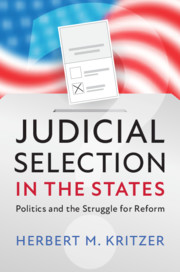Book contents
- Judicial Selection in the States
- Judicial Selection in the States
- Copyright page
- Dedication
- Contents
- Figures
- Tables
- Preface
- Table of Cases
- 1 Introduction
- Part I Change as an Exercise in Partisan Politics
- 2 North Carolina
- 3 Arkansas
- 4 West Virginia
- 5 Tennessee
- Part II Change as Court Modernization or Good Government
- Part III Unsuccessful Change Efforts
- Index
3 - Arkansas
Third Time Was the Charm
from Part I - Change as an Exercise in Partisan Politics
Published online by Cambridge University Press: 06 April 2020
- Judicial Selection in the States
- Judicial Selection in the States
- Copyright page
- Dedication
- Contents
- Figures
- Tables
- Preface
- Table of Cases
- 1 Introduction
- Part I Change as an Exercise in Partisan Politics
- 2 North Carolina
- 3 Arkansas
- 4 West Virginia
- 5 Tennessee
- Part II Change as Court Modernization or Good Government
- Part III Unsuccessful Change Efforts
- Index
Summary
It took three tries for Arkansas to make the change from partisan to nonpartisan elections. Twice, in 1970 and 1980, proposals for revising the state constitution that included changing to nonpartisan judicial elections were rejected by the voters. By 1999, when yet a third proposal was authorized by the legislature, Republican strength in the state had increased substantially. However, there were many more Democrats running for judicial office than Republicans. Because, historically, primary elections were entirely the responsibility of the parties, the parties set and collected filing fees from candidates running in their party primaries. Filing fees from judicial candidates constituted a significant source of revenue for the Democratic Party but not for the Republican Party. The combination of Democratic concerns that Republicans would start winning an increasing share of judicial offices and the Republican desire to deprive the Democratic Party of the revenue from filing fees paid by large numbers of judicial candidates provided the motivation for the legislature to pass and send to the voters another amendment changing to nonpartisan elections.
- Type
- Chapter
- Information
- Judicial Selection in the StatesPolitics and the Struggle for Reform, pp. 58 - 74Publisher: Cambridge University PressPrint publication year: 2020

